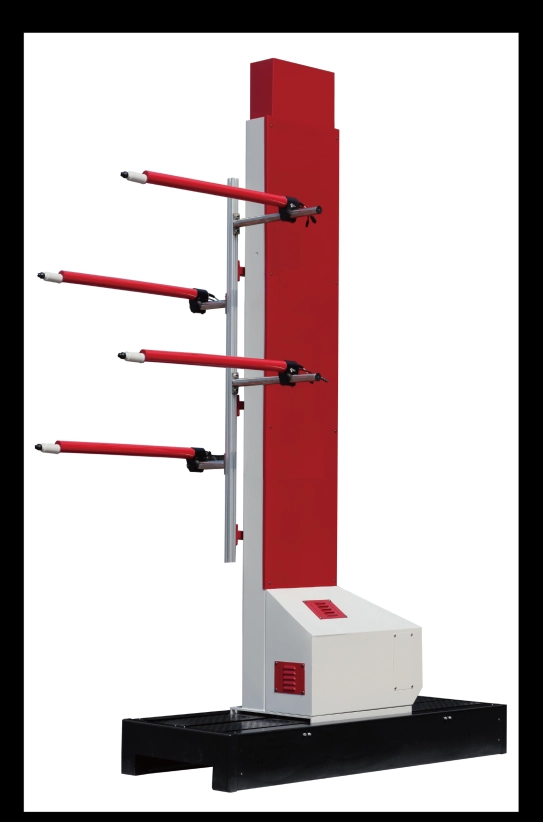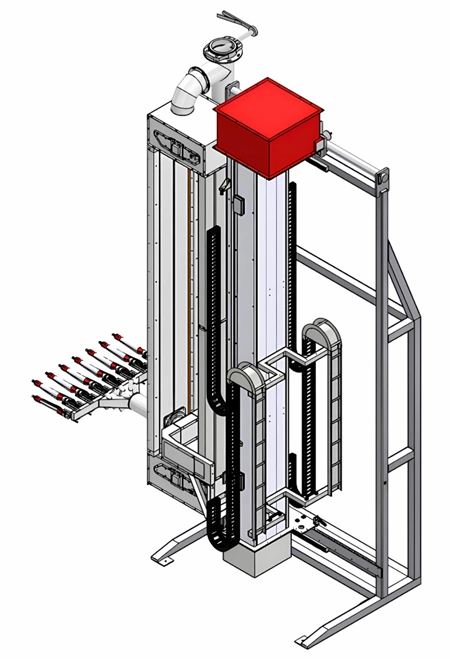Content Menu
● Understanding Powder Coating and Its Energy Demands
>> What is Powder Coating?
>> Why Focus on Energy Efficiency?
● Key Factors for Choosing an Energy-Efficient Powder Coating Spray Gun
>> Transfer Efficiency
>> Compressed Air Consumption
>> Electrostatic Charging Technology
>> Ergonomics and Application Speed
>> Maintenance and Durability
● Top Spray Gun Unit Options for Energy-Efficient Powder Coating
>> 1. Wagner Thermo Gun TG PFP
>>> Energy-Saving Features
>>> Performance Highlights
>> 2. Gema OptiCenter X Powder Coating System
>>> Integration and Efficiency
>>> Performance Highlights
>> 3. Nordson Encore HD Spray Gun
>>> Robust and Efficient
>>> Performance Highlights
>> 4. SATA Powder Gun HTE
>>> Precision with Low Energy Draw
>>> Performance Highlights
>> 5. Anest Iwata Evo-1 Series
>>> Advanced Charging Technology
>>> Performance Highlights
● Practical Tips for Optimizing Spray Gun Energy Efficiency
>> Proper Gun Setup and Maintenance
>> Adjust Air Pressure Sensibly
>> Use the Right Powder and Techniques
>> Implement Automated Controls
>> Train Operators
● Frequently Asked Questions (FAQs)
>> 1. What factors most influence energy consumption in powder coating spray guns?
>> 2. Can manual spray guns be as energy efficient as automated ones?
>> 3. How does spray gun design affect compressed air usage?
>> 4. Are energy-efficient spray guns more expensive?
>> 5. What routine maintenance helps maintain spray gun energy efficiency?
● Conclusion
Powder coating is a widely used finishing process that provides durable, high-quality coatings for metals, plastics, and other materials. As industries strive to improve sustainability, energy efficiency in powder coating systems has become a key focus. One of the most important components influencing both energy consumption and finish quality is the spray gun unit. Selecting the right spray gun not only enhances coating performance but also minimizes energy waste, reduces operational costs, and supports environmental goals.
In this article, we will explore the best spray gun options for achieving energy-efficient powder coating. We will discuss the fundamental principles of powder coating, factors to consider when choosing a spray gun, and review several leading spray gun units that stand out in terms of energy efficiency, application precision, and overall value. Additionally, practical tips for optimizing spray gun usage to save energy will be shared.

Understanding Powder Coating and Its Energy Demands
What is Powder Coating?
Powder coating is a finishing process where a dry powder composed of finely ground particles of pigment and resin is electrostatically charged and sprayed onto a grounded workpiece. The charged powder adheres to the surface and is then cured in an oven, where it melts and flows to form a uniform, high-quality finish.
Unlike liquid paints, powder coating produces minimal volatile organic compounds (VOCs), making it environmentally friendly. However, the process requires energy for spraying, curing, and preparation, which has prompted the industry to seek more efficient alternatives and components.
Why Focus on Energy Efficiency?
The powder coating process involves three main energy-consuming stages: pretreatment, powder application, and curing. While curing ovens consume a significant amount of energy, the application phase, where powders are sprayed electrostatically, also introduces energy costs via compressed air usage, electrostatic charging units, and control systems.
Energy efficiency in spray guns can reduce compressed air consumption, improve transfer efficiency (thereby reducing wasted powder and rework), and optimize electrostatic processes. This translates into lower operational costs, reduced environmental impact, and enhanced overall productivity.
Key Factors for Choosing an Energy-Efficient Powder Coating Spray Gun
Selecting the right spray gun requires balancing energy savings with performance and ease of use. Below are the critical factors to consider:
Transfer Efficiency
Transfer efficiency refers to the percentage of powder that successfully adheres to the target surface. Higher transfer efficiency means less powder waste and reduced overspray, which lowers energy consumption needed to generate airflow and electrostatic charge.
Spray guns with advanced electrostatic charging technology and optimized powder delivery mechanisms typically offer better transfer efficiency.
Compressed Air Consumption
Spray guns that use less compressed air reduce energy demand because compressing air is energy-intensive. Some modern spray guns are designed for reduced airflow without compromising powder delivery or coating quality.
Electrostatic Charging Technology
The method and efficiency of imparting an electrostatic charge to the powder particles influence energy consumption. Efficient high-voltage power units that minimize power loss while maintaining effective charging improve overall energy efficiency.
Ergonomics and Application Speed
Faster application times reduce overall energy use for coating runs. Spray guns that are lightweight and easy to maneuver help operators apply powder more quickly and accurately, improving throughput and reducing waste.
Maintenance and Durability
Durable spray guns that require less frequent servicing or replacement consume fewer resources over time. Additionally, easy-to-maintain systems minimize downtime and prevent inefficiencies caused by equipment degradation.
Top Spray Gun Unit Options for Energy-Efficient Powder Coating
Let's delve into some of the best spray guns currently available that excel in energy efficiency.
1. Wagner Thermo Gun TG PFP
Energy-Saving Features
The Wagner Thermo Gun TG PFP spray gun is known for its compact design and high transfer efficiency. It employs an innovative powder charging system that optimizes electrostatic charge with minimal power usage. Its powder delivery system requires less compressed air compared to traditional guns, conserving energy without sacrificing coating quality.
Performance Highlights
- Transfer efficiency is improved through optimized nozzle design
- Lightweight and ergonomic, reducing operator fatigue
- Suitable for a wide range of powder types and part geometries
This gun is particularly advantageous in automated or manual processes aiming for energy-conscious operations.
2. Gema OptiCenter X Powder Coating System
Integration and Efficiency
While the Gema OptiCenter X represents a full powder coating system, its spray gun component is integral to its energy efficiency. The gun features an optimized high-voltage technology that provides consistent charging with reduced energy consumption. It also includes intelligent airflow management to minimize compressed air wastage.
Performance Highlights
- Precision in powder application via improved control electronics
- Reduced overspray and high transfer efficiency
- Compatible with automated robotic systems, enabling faster cycles
The advanced control features help users fine-tune parameters to balance energy use with coating quality for diverse production needs.
3. Nordson Encore HD Spray Gun
Robust and Efficient
The Nordson Encore HD uses a patented electrostatic system that reduces power requirements while enhancing powder deposition rates. The gun's design lowers compressed air demand and includes quick-change components to shorten maintenance time.
Performance Highlights
- High transfer efficiency, especially on complex shapes
- Energy-saving electrostatic power supply
- User-friendly maintenance reduces downtime
This model is favored for high-production facilities seeking durable equipment with energy-efficient features.
4. SATA Powder Gun HTE
Precision with Low Energy Draw
SATA's Powder Gun HTE is engineered for high transfer efficiency with a relatively low compressed air consumption. Its adjustable charging and airflow controls allow fine customization for different powder types and workpieces.
Performance Highlights
- Excellent powder cloud control reduces waste
- Lightweight design improves operator efficiency
- Versatile for manual and automated applications
The blend of efficiency and operator comfort makes it a popular choice in shops focusing on sustainability.
5. Anest Iwata Evo-1 Series
Advanced Charging Technology
Anest Iwata's Evo-1 series spray guns utilize an advanced electrostatic charging system that delivers uniform powder particles with less power use. The design minimizes recoil forces, giving better control and faster application.
Performance Highlights
- Low compressed air and electricity consumption
- Superior coating uniformity even at reduced energy inputs
- Modular components simplify servicing
This option suits high-end finishing operations where energy optimization aligns with quality demands.
Practical Tips for Optimizing Spray Gun Energy Efficiency
Proper Gun Setup and Maintenance
Regularly calibrate and maintain your spray gun to ensure components such as nozzles and electrodes function optimally, reducing powder wastage and energy drain.
Adjust Air Pressure Sensibly
Avoid using excess compressed air pressure beyond recommended levels. Excess airflow not only wastes energy but also increases powder bounce-back and overspray.
Use the Right Powder and Techniques
Selecting suitable powder materials compatible with your spray gun and applying correct coating techniques improves transfer efficiency, ultimately conserving energy.
Implement Automated Controls
Automated spray systems with real-time monitoring and control can optimize the powder application dynamically, minimizing overuse of air and voltage.
Train Operators
Operator skill significantly impacts energy use. Well-trained technicians apply powder efficiently, reduce retries, and maintain equipment better, all contributing to lower energy consumption.
Frequently Asked Questions (FAQs)
1. What factors most influence energy consumption in powder coating spray guns?
Transfer efficiency, compressed air consumption, and the electrostatic charging process are the main factors. Better transfer rates reduce wasted powder, and lower compressed air needs conserve energy.
2. Can manual spray guns be as energy efficient as automated ones?
Yes, some manual spray guns incorporate advanced technology to improve energy efficiency. However, automated systems often have superior control and consistency, leading to further energy savings.
3. How does spray gun design affect compressed air usage?
Nozzle and powder delivery design influence how much air is needed to transport powder adequately. Efficient designs use less air to create a dense, well-controlled powder cloud.
4. Are energy-efficient spray guns more expensive?
Initial costs may be higher for advanced models, but savings in powder usage, electricity, and compressed air typically offset the investment over time.
5. What routine maintenance helps maintain spray gun energy efficiency?
Cleaning nozzles and electrodes, inspecting seals, and timely replacement of worn parts prevent excess powder waste and ensure efficient electrostatic charging.

Conclusion
Energy-efficient powder coating spray guns play a crucial role in sustainable manufacturing. Investing in high-transfer-efficiency guns with optimized compressed air use and advanced electrostatic charging can significantly reduce operational energy costs. Brands like Wagner, Gema, Nordson, SATA, and Anest Iwata offer spray gun units designed to optimize energy use while maintaining high-quality finishes. Coupled with good practices and maintenance, these options empower users to achieve greener coating operations without compromising performance.
Hot Tags: China, Global, OEM, private label, manufacturers, factory, suppliers, manufacturing company










































 .
. 